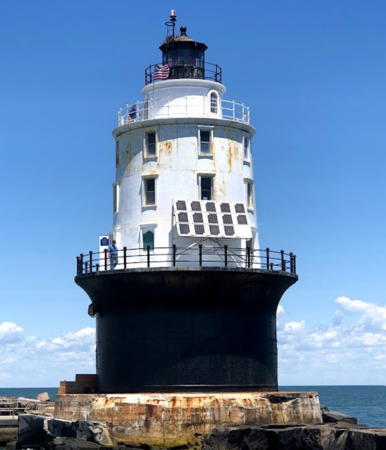|

Sharps Island Light, Tilghman Island, Maryland, July 2004
Flickr Creative Commons photo by Craig Bruce
|
Preservation of sparkplug lighthouses is not an easy
business. The iron towers rust and deteriorate quickly if
they are not painted regularly. The towers are exposed to
damage from waves, winter ice, and collision with ships. It
was ice that pushed the Sharps Island Light over at a
15° angle in the winter of 1976-77 (see photo at left).
A winter storm toppled the former Crabtree
Ledge Light in Maine. Rust and decay caught up with the
Deer Island
Light in Boston Harbor, demolished in 1982.
Some of the sparkplugs are close to shore, but most are
several miles out in the water, too far for convenient
access. The Coast Guard has acted to place many of them under the National Historic Lighthouse
Preservation Act process, with mixed results. Because it would be difficult to provide public access, preservation groups have been reluctant to accept ownership of these lighthouses, so many of them are being auctioned off to private owners. Several of these owners have invested heavily in restoring their lighthouses, but others seem overwhelmed by the task and have made little progress.
Despite these difficulties, there have been a number of successful
efforts to preserve sparkplug lighthouses.
- In Plymouth, Massachusetts, Project
Bug Light led restoration projects for the Duxbury Light in
the mid-80s and again in the mid-90s.
- In Lubec, Maine, public pressure convinced the Coast Guard to
restore the Lubec Channel Light in 1993-94 instead of demolishing
it.
- At Sakonnet, Rhode Island, the Friends of Sakonnet Point
Lighthouse restored the abandoned sparkplug light and reactivated
it in 1997. A complete restoration of the lighthouse was nearing completion in 2012.
- In 1999, the Portland
Harbor Museum took control of the Spring Point Ledge Light,
which is linked to shore by a breakwater, and opened it for guided
tours.
- In Michigan, the Harbor Beach Lighthouse and Breakwall
Preservation Society is working to preserve Lake Huron's only
sparkplug tower.
- In Delaware, the Delaware
River and Bay Lighthouse Foundation has taken ownership of the
Harbor of Refuge Light and is working to restore the building.
Since 2003 the lighthouse has been open for public tours. In 2004
DRBLHF expanded its preservation efforts to include the nearby
Delaware Breakwater Light, and that light opened to the public
for the first time in the summer of 2005.
- In Rhode Island, the Friends
of Plum Beach Lighthouse carried out in 2003 the difficult
task of restoring and reactivating a sparkplug tower inactive for
nearly 60 years.
- The city of Warwick, Rhode Island, received the title to
Conimicut Light in September 2004 and is moving ahead with plans
for restoration.
- The Noble Maritime Collection, Staten Island, has taken ownership of Robbins Reef (Kate's) Light and is working to restore it.
- Westchester County and the Village of Sleepy Hollow are working to restore the Tarrytown Lighthouse.
|




